This time last year I was given the idea of travelling along the Silk Road from Istanbul to Pakistan. Central Asia was somewhere I had never even considered visiting but the idea grew and grew until I just had to do it.
Fortunately I got the eight visas I should need before I left home and what a to do that was. How could I possibly tell when I would be where and in the case of Turkmenistan I not only had to adhere to the date but the time of day as well! But on the 27th March I flew out of T5 on its inaugural day and was one of the very few lucky ones whose flight took off (five hours late) and whose luggage arrived too.
From Istanbul I bussed it to Antakya which I was sad to find was a dismal town, made more dismal by the rain and from there into Syria and the magic of Aleppo then on to Hama for the Norias, Palmyra in the desert and a real sand storm and of course Damascus. I had hoped to catch the train from there to Tabriz in Iran, but despite being told to the contrary beforehand that I would be able to change Travellers Cheques in Syria, this proved not to be the case, so I returned to Turkey and entered Iran in the shadow of Mount Ararat.
Despite all the Foreign Office advice about travelling in Iran, I found it incredibly easy. Everyone was so helpful, making sure I wasn’t too diddled with taxi fares, feeding me on bus and train journeys and even paying my bus fare or museum entrances if I wasn’t looking. Two weeks was barely enough to see the highlights of Persepolis, Esfahan, Yazd, Shiraz and Mashad, let alone Tehran but it’s good to think I have enough left for another visit.
Turkmenistan could not have been more different and I am glad to have seen Ashgabat but glad I was only there one night. The long drive through the desert with the guide I was obliged to have before a visa would be granted (at huge expense) was interesting for the first 3 hours but less so for the second 3 as the scenery didn’t change. Arriving at the ancient site of Merv though was well worth it. This is a vast site and just could not be done on foot and luckily the guide I had had a passion for archaeology and history which made the vast mud structures come alive. One night there and another long drive through the desert to Uzbekistan.
Over the border and narrowly avoiding getting arrested because in my frustration I cracked a joke which was misunderstood – great mistake – and the first place I made for was Bukhara. From there another long drive through the same desert to Khiva and back to Bukhara before a train to Samarkhand. All these cities were just wonderful. So much to see and experience, but of course the jewel was Samarkhand. A few days spent in Tashkent and I was off to Kyrgyzstan
I took to the air and flew into Bishkek only to find accommodation at a premium and I ended up spending the night in a flat in the most unsavoury part of town. So unsavoury that not only was I advised not to be out after dark, and to lock the flat door twice, but at the end of the corridor there was a cage door which also had to be locked. One night there and I was off to Karakol on lake Issy Khul in a minibus. For what reason I do not know, but I didn’t take to Kyrgyzstan, so cut my visit short and headed down to Osh on the Chinese border. If only I had wanted a hat and if only I’d had some room in my rucksack, I could have bought any number of wonderful hats in Osh Market, but I hadn’t so I didn’t!
I shared a car ride with a young American lad who had been teaching English in Japan for a year and spending some time travelling around Central Asia before heading home. As the journey took two days with an overnight stay on a cold concrete floor in Sary Tash, it was great to have some company. The ride up through the Pamir Mountains was wonderful and dotted all along the route were yurts where the herding families had moved up to the high pastures for the summer.
We rose at 4.30 to drive the rest of the way from Sary Tash to the Chinese border and the Milky Way was beautiful, I felt as though I could just reach out and touch it. As the sun rose it turned the snow capped mountains a real Barbie pink and I am sure these memories will far outlast those of extremely bumpy roads, no food, cold and a car which had to stop every few miles to have cold water poured over its engine.

It took five or six hours to cross the border as my companion had a Lonely Planet guide book with a map of China which showed Taiwan, so we were asked on several occasions to have our bags searched. Also coming through at the same time was the night bus and that had several thorough searches, but we got a lift through to Kashkar on it and met two more fellow travellers with whom to share news and tales.
Kashgar’s main square had been taken over by hundreds of school children all practicing their various performances for when the Olympic Torch was to come through the town, all under the watchful gaze of Chairman Mao’s huge statue. This city was a lovely mix of very old and very new, with, of course, the world-famous Sunday market and best of all for me by now, after what seemed like months and months of nothing but boiled rice and chewy fatty lamb and hard bread, a wonderful choice of food at John’s Café. Egg and chips had never tasted so good.
Another two day bus ride and an overnight stay, this time in Tashkurgan on the way to Pakistan. The bus passengers were a mix of Chinese workers on their way to widen the Karakoram Highway, Pakistan business men returning with their wares, a Swiss woman, a young Englishman, a French Algerian an Italian and me. The ride up into the Karakorams passing yaks, marmots and eagles was spectacular. I could see glaciers and the mountains just got bigger and bigger. Crossing the border at the Khunjerab Pass, the highest paved border crossing in the world was a great experience albeit tinged with a little altitude sickness. The road on the Chinese side was well-maintained and we drove at a steady 30 miles an hour but the moment we crossed the border all the Pakistanis on board gave out a wonderful cheer, the un-maintained road became bumpier and bumpier and the driver put his foot on the accelerator and we drove at an horrendous speed down the KKH with frightening precipices. From this description you will have gathered that I am a coward and don’t do mountains and twisty turny roads with big drops, so I got off the bus at Passu and thought I had landed in Heaven.
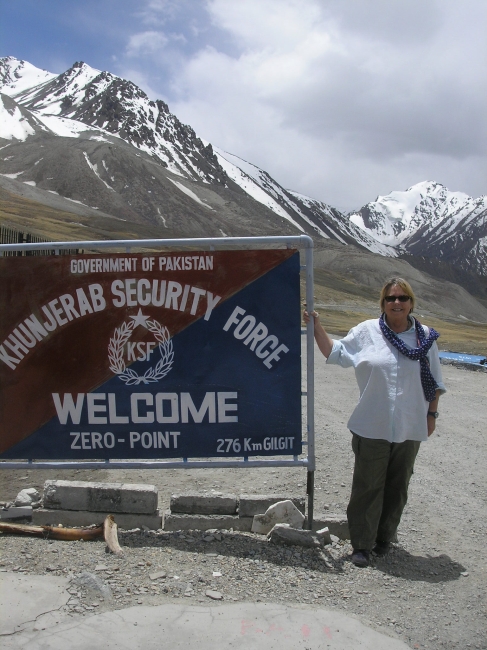
I stayed at a modest Inn where the owner cooked delicious dinners, I could pick handfuls of deep red cherries and the views and peace were wonderful. But too soon it was off down the dreaded road with eyes shut tight and fists and teeth clenched to Karimabad. As with everywhere in the Hunza Valley I encountered only hospitality and kindness tempered with good humour. A jeep ride to see the sun set behind Rakaposhi and the Ladies’ Finger was made all the more enjoyable by giving a lift to two women who had spent the day toiling in the fields and although weary were still full of fun and full of questions and laughter.
After several happy days staying at the Mulberry Tree I travelled once again down to Gilgit where I met up with the other travellers who had been on the bus from Kashgar. Samosas at sunset by the rushing Gilgit river, card playing with locals in the hotel, haggling in the bazaar made the days rush by. My dread of the twenty hour overnight bus ride down to Islamabad along the Karakoram Highway and in view of the fact that flights were being cancelled due to bad weather (not that flying from Gilgit was much of a more attractive alternative), decided me to try to find another way south.
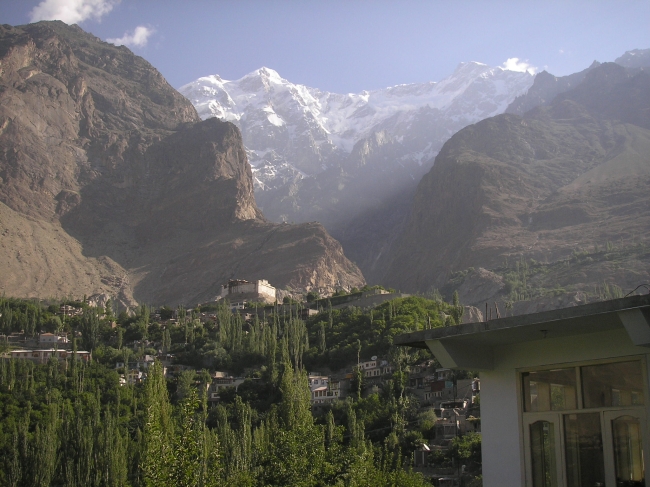
By great good fortune I met with a young jeep driver who was going that way and we set off at 5 am at 5.30 as the sun was rising behind Nanga Parbat or Killer Mountain we came to the point where the Karakorams, Hindu Kush and Himalayas meet – just magical. The route he took me was over the Barbusa Pass which was just the most amazing, action-packed 23 hour journey you could possibly imagine. Climbing high above the snow line, for the most part traversing tracks barely wide enough for a jeep, being stopped by cattle, Kalashnikov carrying tractor drivers stuck in the mud, driving through Osama Bin Laden supporting Afghan refugee tent cities, stone throwing children running along side, work men rock-blasting causing land slides and so much more. All the while going from magnificent mountains down into heart-achingly beautiful valleys. Just wonderful.
My last few days were spent in Rawalpindi staying in a hotel run by Hunza people and my Hunza jeep driver showed me around the city. I had been travelling for three months and not once did I have an unpleasant experience. Yes, a few dodgy taxi drivers and maybe I paid over the odds a few times but that’s part of the fun. All the peoples I met were kind and welcoming but the people of the Hunza Valley were unbelievable. Their honesty, hospitality and warmth were such that I have already arranged to return next year and this time will stay for several months. In Sha Allah.
What a really great end to a really wonderful journey along part of the old Silk Road.




 A British ‘Marco Polo’ who travelled the world on his bicycle for 40 years has been killed in a hit-and-run road crash in Greece. Ian Hibell, 74, was dubbed a “cyclist extraordinaire” in the long-distance touring world and rode across every continent and some of the most remote parts of the planet. He undertook countless expeditions over 40 years that were classed as ‘world firsts’ including an overland Trans-Americas expedition from Cape Horn to Alaska, between 1971 and 1973. During his 250,000 miles of cycling across deserts and glaciers he was shot at by bandits, nearly eaten alive by tropical ants, stuck in mangrove swamps, chased by rogue elephants and once faced down a hungry lion. He enjoyed the hospitality of an Eskimo princess, a Dyak headman in Borneo, African chiefs and missionaries and once asked for a two-year sabbatical from work – only to return ten years later.
A British ‘Marco Polo’ who travelled the world on his bicycle for 40 years has been killed in a hit-and-run road crash in Greece. Ian Hibell, 74, was dubbed a “cyclist extraordinaire” in the long-distance touring world and rode across every continent and some of the most remote parts of the planet. He undertook countless expeditions over 40 years that were classed as ‘world firsts’ including an overland Trans-Americas expedition from Cape Horn to Alaska, between 1971 and 1973. During his 250,000 miles of cycling across deserts and glaciers he was shot at by bandits, nearly eaten alive by tropical ants, stuck in mangrove swamps, chased by rogue elephants and once faced down a hungry lion. He enjoyed the hospitality of an Eskimo princess, a Dyak headman in Borneo, African chiefs and missionaries and once asked for a two-year sabbatical from work – only to return ten years later.

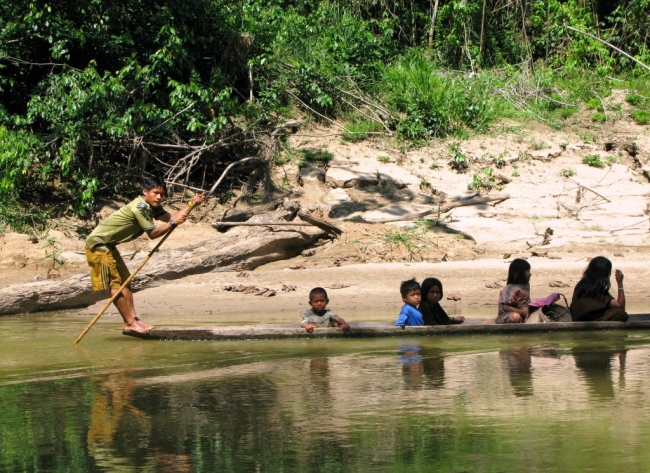 Picture courtesy of The Ant: boating the traditional way, up the Rio Amônia past Apiwxta
Picture courtesy of The Ant: boating the traditional way, up the Rio Amônia past Apiwxta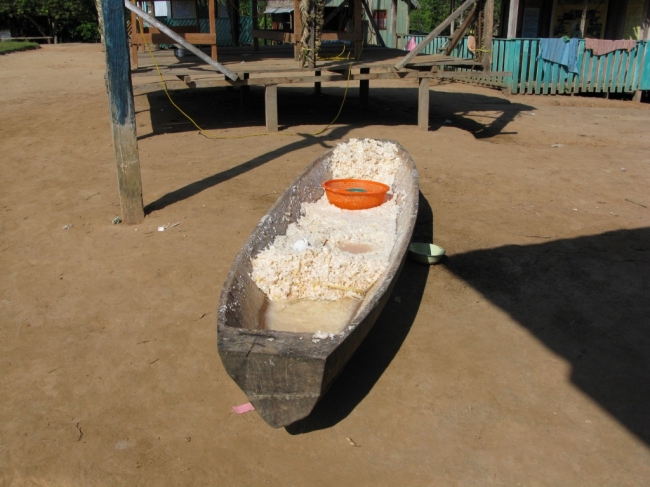 Picture courtesy of The Ant: Tome boat at Sawawo…the morning after!!!
Picture courtesy of The Ant: Tome boat at SawawoÂ…the morning after!!!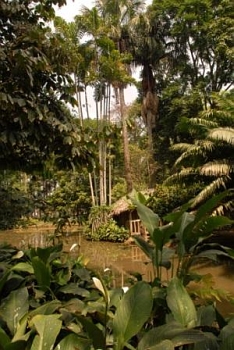 I saw our future and the future was green, not just the sea of green we were flying low over with the occasional break in that verdant mass below, revealing a river with its golden banks meandering through the luxuriant forest. It has been sometime since I had been with a group of VIPs but now instead of doing a sword dance with a Saudi Prince I was in a small twin engined plane flying over the rich green rainforest of the State of Acre in Brazil accompanying Mm Danielle Mitterrand, the widow of a past French President, The Ministra do Meio Ambiente from Brasilia, the Governor of Acre and the usual body guard, TV cameraman etc. which follow VIPs. Last, but not least of all was Joao Fortes the leader of our small group and passionate helper of the Indians for more than twenty years, Cristina MendonÃĤa (expert on carbon credits), Maria Alice, whose expertise was to help the Indians make the right craft goods that would sell in the outside world.
I saw our future and the future was green, not just the sea of green we were flying low over with the occasional break in that verdant mass below, revealing a river with its golden banks meandering through the luxuriant forest. It has been sometime since I had been with a group of VIPs but now instead of doing a sword dance with a Saudi Prince I was in a small twin engined plane flying over the rich green rainforest of the State of Acre in Brazil accompanying Mm Danielle Mitterrand, the widow of a past French President, The Ministra do Meio Ambiente from Brasilia, the Governor of Acre and the usual body guard, TV cameraman etc. which follow VIPs. Last, but not least of all was Joao Fortes the leader of our small group and passionate helper of the Indians for more than twenty years, Cristina MendonÃĤa (expert on carbon credits), Maria Alice, whose expertise was to help the Indians make the right craft goods that would sell in the outside world. Picture by Tony Annis : Benki and friends at his home with the Ashaninkas
Picture by Tony Annis : Benki and friends at his home with the Ashaninkas